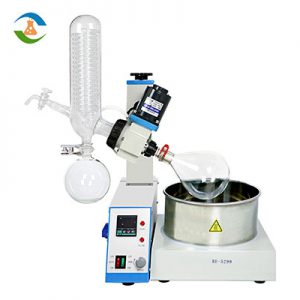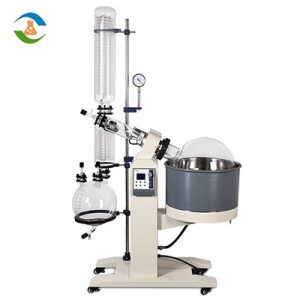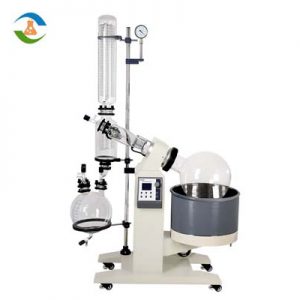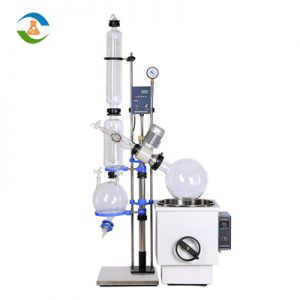Introduction to Large Scale Rotary Evaporator
The D-RE-5002 rotary evaporator with a 50L flask capacity and a 20L receiver flask capacity is designed for handling large volumes of samples and can hold volumes up to 50L. The large scale rotary evaporator is equipped with a high-performance motor and vacuum pump to ensure fast and efficient evaporation. For the efficient and gentle removal of solvents from samples by evaporation in the chemical, pharmaceutical and biotechnology industries, as well as in academic research laboratories.
Grouped equipment
DLSB-50/30 low temperature coolant circulation pump
Capacity: 50L; Minimum no-load temperature: -30°C; Power 100W
SHZ-C vertical vacuum pump
Capacity: 50L; Maximum vacuum: 0.098MPa
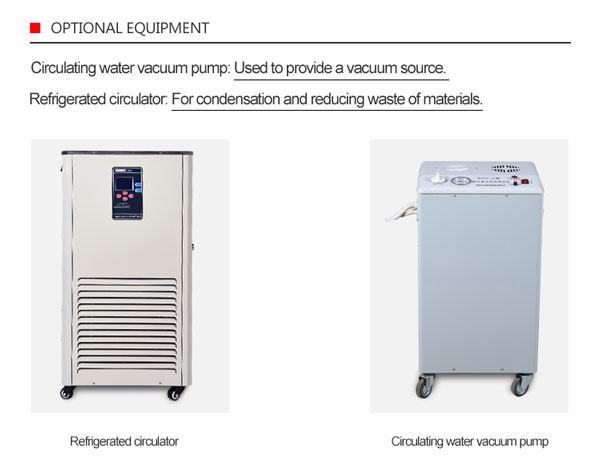
Large Scale Rotary Evaporator structure
-
Heating Bath:
Usually a water or oil bath, used to heat the vials and evaporate the solvent. Baths are usually temperature controlled and can be adjusted to the desired temperature for a particular application.
-
Spinning Flask:
This is the container for the sample to be evaporated, large volume, usually made of glass and attached to a rotating shaft. The sample is swirled in the flask to increase the surface area and aid in the evaporation process.
-
Condenser:
A component that condenses evaporated solvent back into liquid form. The condenser is usually cooled with water or another coolant to help condense the steam.
-
Vacuum system:
A vacuum pump is used to reduce the pressure in the system, which helps to speed up the evaporation process by lowering the boiling point of the solvent.
-
Control Panel:
The control panel is used to adjust the temperature of the heating bath, the speed of the spinner, and other variables such as vacuum pressure and evaporation time.
-
Glassware:
Rotary evaporators typically come with a set of glassware, including vials, condensers, and other components required for a particular application.

Large Scale Rotary Evaporator Application
Solvent removal:
large scale rotary evaporator is commonly used in the chemical and pharmaceutical industries, as well as the separation of compounds.
Concentration:
This can be used to produce drugs and other compounds.
Distillation:
large scale rotary evaporator can be used for the separation of volatile compounds and the production of essential oils.
Operating procedures
(1) Preparation
After assembling the machine, connect the cryopump and vacuum pump according to the connection diagram of the supporting equipment;
- Turn on the cryopump
- Turn on the vacuum pump, start vacuuming, and pay attention to the reading of the vacuum gauge. When the vacuum gauge maintains the maximum vacuum for a period of time, it indicates that the equipment is well sealed and can start feeding.
(2) Feeding
- Feeding method: first pump the large scale rotary evaporator into a negative pressure state, connect the feeding valve with the sample to be added with a hose, open the valve of the feeding valve, and the sample will be directly pumped into the rotary bottle, after the feeding is completed Close the fill valve valve. It is recommended to add no more than one-half of the spinner bottle each time.
(3) Operating the heating bath
- Adjust the height of the heating bath so that the spinner bottle is placed in the water bath.
Adjustment method: manual lifting, turn the lifting wheel on the heating bath, clockwise to rise, reverse to fall.
- Pour pure water into the bath, submerge 1/2 of the spinner bottle, just don’t overflow.
- Switch on the power supply to the heating bath.
- Set the temperature via the temperature controller on the right side of the heating bath.
(4) Operation rotation
- First turn the speed control knob on the speed control box to the minimum left, then turn on the power of the rotating motor, turn it up to turn on the power switch, the indicator light is on, the display screen of the speed control box is on, and then slowly turn right to the required speed .
(5) Shutdown.
- First stop the heating bath;
- Turn off the rotary switch;
- Open the inlet and outlet valves to release the vacuum;
- Finally turn off the vacuum pump and cryopump.
- Disposal after downtime: When not in use for a long time, please turn off and disconnect the power supply.
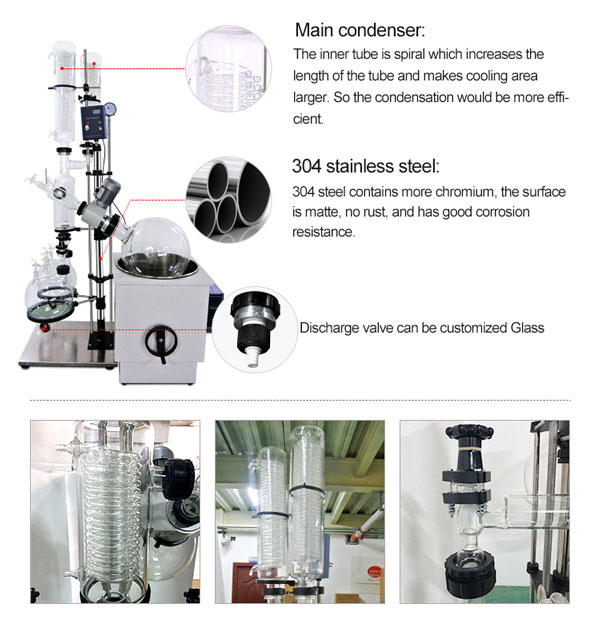
Parameter
| Mol | Rotating Motor(W) | Water(Oil) Bath Power(W) | Temperature Control Range | Evaporation Rate(H2O) | Voltage | Lifing Height(mm) |
| RE-2000B | 40 | 1500 | RT~99℃ | ≥1L/h | 220V/50HZ | 0~140 |
| RE-5299 | 30 | 1500 | RT~99℃ | ≥1L/h | 220V/50HZ | 0~150 |
| RE-201D | 40 | 1200 | RT~399℃ | ≥1L/h | 220V/50HZ | 0~150 |
| RE-301 | 40 | 1500 | RT~399℃ | ≥1.5L/h | 220V/50HZ | 0~120 |
| RE-501 | 40 | 1500 | RT~399℃ | ≥1.5L/h | 220V/50HZ | 0~120 |
| RE-1002 | 180 | 3000 | RT~99(250)℃ | >3L/h | 220V/50HZ | 0~220 |
| RE-2002 | 180 | 5000 | RT~99(250)℃ | >5L/h | 220V/50HZ | 0~220 |
| RE-5002 | 250 | 7000/9000 | RT~99(250)℃ | >9L/h | 380V/50HZ | 0~220 |
| RE-2000B | 40 | 1500 | RT-99 Temperature control accuracy ±1℃ | ≥1 | 220V 50/60HZ | 0-140 |
| EXRE-1002 | 180 | 3000 | 0-99(250) | >3 | 220V 50/60HZ | / |
| EXRE-2002 | 180 | 5000 | 0-99(250) | >5 | 220V 50/60HZ | / |
| EXRE-5002 | 370 | 7000/9000 | 0-99(250) | >9 | 380V/50HZ | / |
| Model | Rotating Motor(W) | Water(Oil) Bath Power(W) | Temperature Control Range |
| RE-2000B | 40 | 1500 | RT~99℃ |
| RE-5299 | 30 | 1500 | RT~99℃ |
| RE-201D | 40 | 1200 | RT~399℃ |
| RE-301 | 40 | 1500 | RT~399℃ |
| RE-501 | 40 | 1500 | RT~399℃ |
| RE-1002 | 180 | 3000 | RT~99(250)℃ |
| RE-2002 | 180 | 5000 | RT~99(250)℃ |
| RE-5002 | 250 | 7000/9000 | RT~99(250)℃ |
| RE-2000B | 40 | 1500 | RT-99 Temperature control accuracy ±1℃ |
| EXRE-1002 | 180 | 3000 | 0-99(250) |
| EXRE-2002 | 180 | 5000 | 0-99(250) |
| EXRE-5002 | 370 | 7000/9000 | 0-99(250) |
FAQ
Q: What are the benefits of using a large rotary evaporator?
A: The benefits of using a large scale rotary evaporator include efficient solvent removal, better sample quality, precise control of the evaporation process, versatility, and cost-effectiveness.
Q: What types of samples can the large rotary evaporator handle?
A: large scale rotary evaporator can be used to process a variety of samples, including organic and inorganic compounds, natural products and polymers.
Q: What safety precautions should be paid attention to when using a large rotary evaporator?
A: Some safety precautions to take when using a large scale rotary evaporator include wearing appropriate personal protective equipment, ensuring proper ventilation, monitoring the temperature and pressure in the system, and being aware of the flammability of the solvents used.


